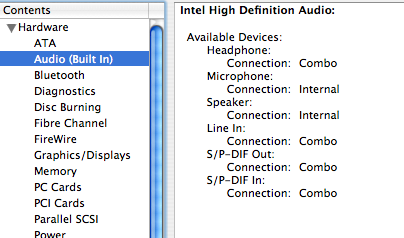Audio Interface
cocoaModem uses numerical algorithms to demodulate and decode digital mode signals. An analog waveform from a radio has to be sampled into a stream of numbers for cocoaModem to use. A device that converts an analog waveform into a digital stream is called an analog-to-digital converter (A/D converter). It is also known as an Audio Interface, or a codec, or a "Sound Card."
For output, the numerical stream of numbers that cocoaModem generates has to be converted into an analog waveform for modulating a radio. A device to perform this is called a digital-to-analog converter (D/A converter). It is also known as an Audio Output Interface, or the output section of a codec or a Sound Card.
The term "Sound Card" comes from the fact that the audio interfaces are often built into PCI cards which plug into the computer backplanes. Today, many sound devices are built into external enclosures which are connected to the computer with a USB or Firewire interface. But the name "Sound Card" continues to be used for them.
Macintosh Built-in Sound
Many models of Macintosh now come with built-in sound input and sound output. The following is a screen shot of the System Profiler on a MacBook Pro

The Line In and Headphone (or Line Out ) connections can be temporarily used as the audio interface for cocoaModem. For long term use, I highly recommend that you use an external Audio Interface instead, especially if you are using a VOX base mechanism (such as a SignaLink) for PTT.
The reason is that the built-in sound outputs are also used in the Mac OS by system chimes, application alert sounds, iTunes music and other sounds. These sounds will modulate your transmitter with potentially illegal signals.
Sampling Rate of Audio Interfaces
An analog signal from the radio is sampled (measured) periodically by the input audio interface. The rate at which you take samples is known as the sampling rate or sample rate of the interface.
From the Nyquist theorem, a band-limited signal can be uniquely represented in the digital domain even if you don't continuously take samples from it, as long as the sampling rate is at least twice that of the highest frequency component (called the Nyquist Frequency) of the analog signal.
With real world implementation, you will need to sample at a little bit more often than twice the highest frequency component in your signal. A sampling rate of 11025 samples/second is sufficient, for example, to accurately represent signals up to 4 kHz.
Software Defined Radios work with a pair of signals, called the In-phase and Quadrature (or I and Q) components. When I and Q components of a signal are available, you will only need to sample at the Nyquist rate to get a complete representation of the same signal.
The sampling rates for sound devices usually come from two families. One of them is based on the 8000 samples/second rate that was used by early researchers of digital telephony at Bell Labs. For wider bandwidths, integer multiples of 8000, such as 16000, 32000, 48000, 96000 and 192000 samples per second are used.
The second family of sampling rates became popular due to Philips' choice of 44100 samples/second as the sampling rate for music CDs that encode analog signals up to 20 kHz. This family of sampling rate includes rates of 11025, 22050 for lower bandwidth signals and 88200 samples per second for higher bandwidth signals.
Most Audio Interfaces that you buy will typically include one or more of the rates from either or both families. Rates of 11025 and 44100 are most often found in consumer products and rates of 96000 and 192000 are typical of what is found in professional recoding equipment.
The built-in sound device on a Macintosh is usually fixed at 44100 samples/second. For compatibility with most Macintosh models, cocoaModem uses either 11025 or 44100 as the two default sampling rates.
Resolution of Audio Interfaces
When the audio devices takes a sample from the analog waveform, it encodes the voltage into a number. The number can be recorded with various resolutions, such as 8, 16, 20 or 24 bits. An 8 bit device can record up to 256 voltage levels, a 16 bit device can record up to 65,536 voltage levels, a 20 bit device can record up to a million voltage levels and a 24 but device can record up to 16 million voltage levels.
An 8 bit device can therefore represent numbers up to a 48 dB range, a 16 bit device can record up to a 96 dB range, and the higher resolution devices have the potential of recording larger ranges.
The resolution of a device merely determines the maximum dynamic range you can achieve with the device; the true dynamic range of an audio interface is also determined by other factors, such as the noise floor and the linearity of the device. A 20 bit device is not a guarantee that it will be better than a 16-bit device.
You must never operate the audio interface so that signals clips or saturates the devices. In the output direction, it will cause severe interference to adjacent stations and can violate the bandwidth requirements of the amateur sub-band that you are operating in. In the input direction, you will get degraded copy of a signal. cocoaModem provides an audio level meter in all of its interfaces so you can monitor if the audio interface is clipped.